Alcea rosea
Are you looking to infuse more attention-grabbing flowers into your garden? Then hollyhocks are perfect for you.
Growing and caring for A. rosea is easy. Their flowers create impressive displays, and they’re also exceptional pollinator plants.
Stunning additions to the garden; they can reach nine feet tall when in flower!


We link to vendors to help you find relevant products. If you buy from one of our links, we may earn a commission.
Their large, green, scalloped or rounded leaves can be inconspicuous in the garden, but these plants are remarkably stunning when they’re in bloom, in a wide range of available colors.
The large flowers make for a perfect landing space for bumblebees, which adds to the whimsical character that hollyhocks bring to a garden. Hummingbirds and butterflies are also attracted to the blooms.
Mixing flower colors creates a cheerful palette, while selecting a specific color makes for an alluring and striking display.
Interplanting them with various varieties of taller flowers is another way to create an eye-catching and impressive presentation in your garden.
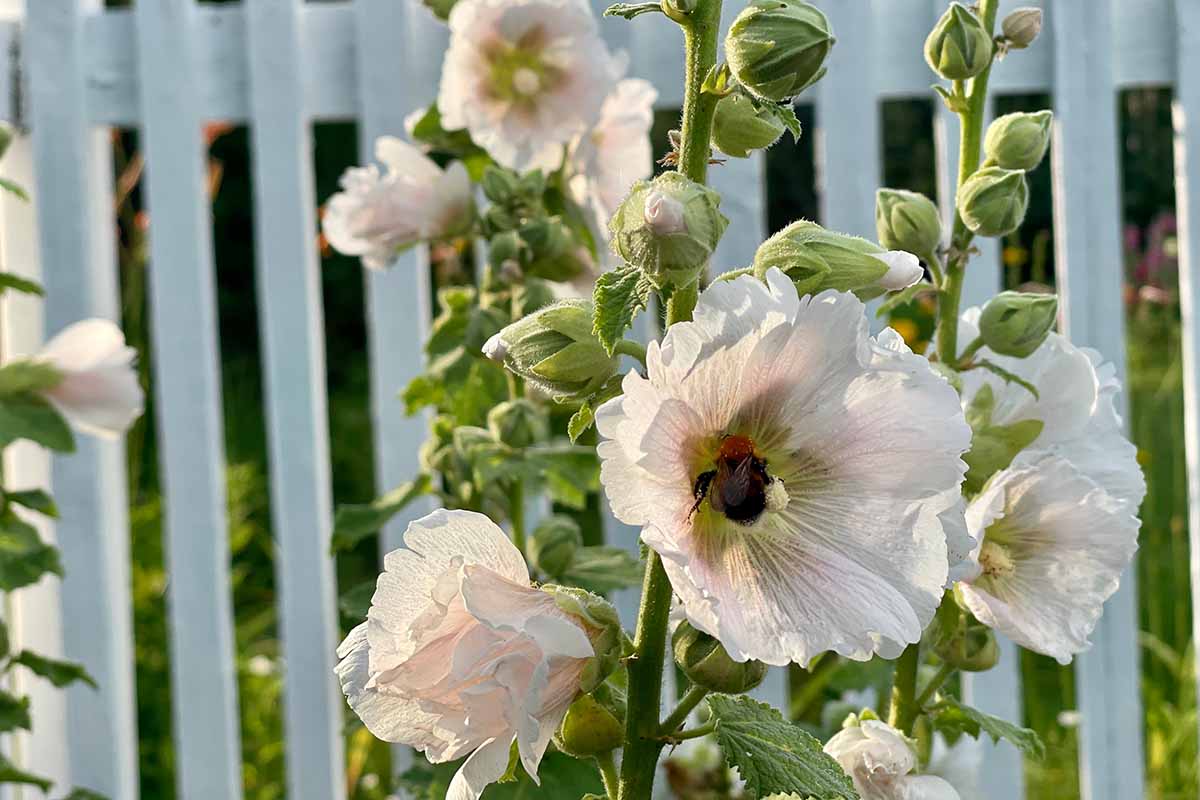

When selecting a variety of hollyhock, you’ll have two flower type options.
It’s important to remember that if you want pollinators to enjoy this plant, choosing a variety with single rather than double blooms is best. Although appealing to us, the extra petals make it difficult for pollinators to access the flower’s nectar.
As if they couldn’t be more magical, once you plant hollyhocks in your garden, they will reseed and continue to return every season. You can leave the seed pods on the flower stalks to self sow or collect and save them for the following season.
Along with being an attractive selection to add to a flower garden, hollyhocks also offer fun crafting opportunities, from making fairy dolls to natural botanical dyeing.
Learn about their history and how to plant and tend to them in your garden in this guide.
The common hollyhock, Alcea rosea, is a flowering biennial or short-lived perennial that belongs to the Malvaceae plant family.
These plants have a long blooming season and can live for a few years in Zones 3 to 9 if you cut back the flower stalks after blooms fade.
Quick Look
Common name(s): Hollyhocks
Plant type: Biennial or short-lived perennial flower
Hardiness (USDA Zone): 3-10
Native to: Asia
Bloom time: Summer
Exposure: Full sun
Soil type: Fertile, loamy, well draining
Soil pH: 6.0-8.0, slightly acidic to alkaline
Spacing: 2-3 feet
Planting depth: Soil surface (seeds), depth of root ball (transplants)
Mature size: 2-4 feet wide x 3-9 feet high
Water Needs: Moderate
Taxonomy
Order: Malvales
Family: Malvaceae
Genus: Alcea
Species: Rosea
Cultivars: Various
This species of hollyhock is said to be native to Asia. Its common name comes from the term “holy hoc” or “holy mallow,” referring to the land from whence they were first introduced to Europe, which was most likely somewhere in Palestine.
By the mid-1500s, hollyhocks made their way to Europe through Britain, becoming popular thanks to the color they brought to stark landscapes. Today, they are a cottage garden staple.
With the number of hollyhocks we see growing now, it’s hard to believe a fungus once threatened their cultivation. However, in 1869, a rust disease spread to Europe and was so destructive that people stopped growing them.
By 1891, hollyhocks made their way back into gardens when horticulturists began developing improved varieties that were resistant to disease.
Propagation
Propagating hollyhocks from seed is easy. But if you want to get a head start, you can also purchase seedlings or potted nursery plants for transplanting.
From Seed
Growing hollyhocks from seed is the best way to propagate this plant. To encourage germination, soak the seeds overnight in warm water before sowing.
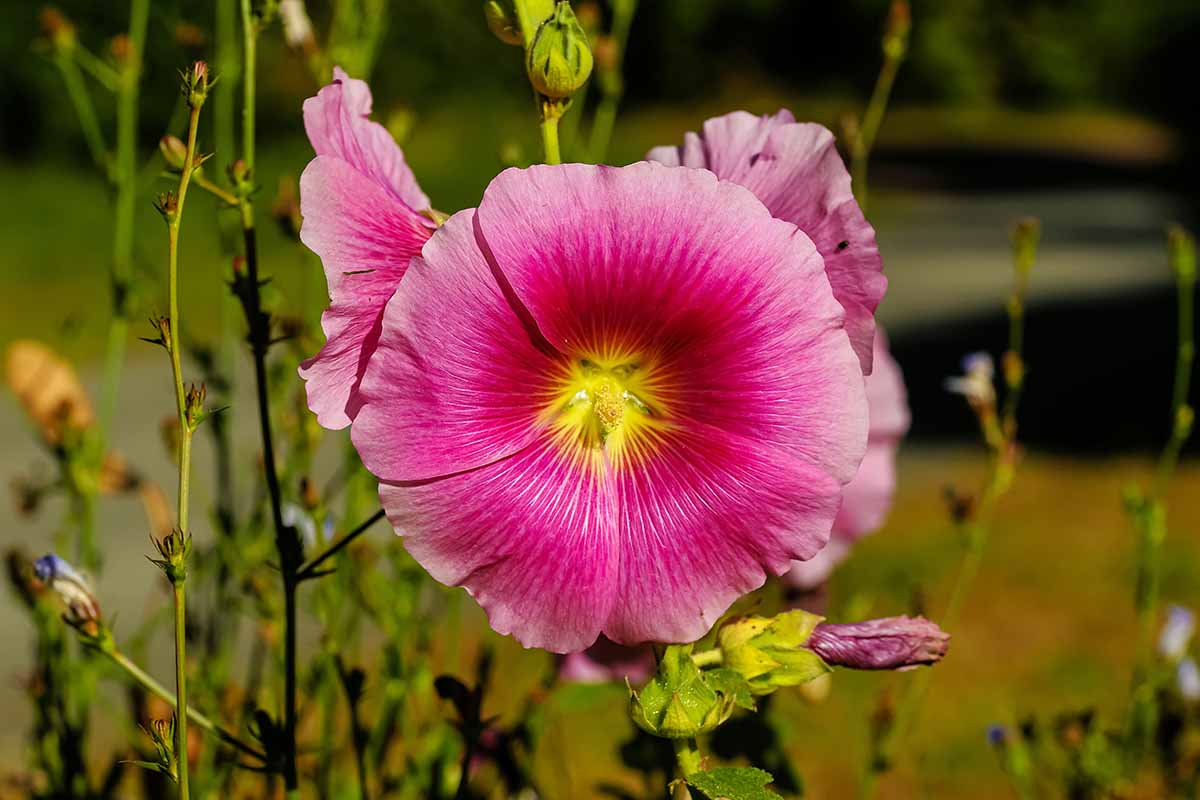

Since the common hollyhock is a biennial, determining when to sow seeds in your climate is important.
In warmer regions, you can sow seeds outdoors during late summer or early fall for flowers the following summer. Those in colder climates can start seeds outdoors after the last frost, with flowers appearing in the second year, during early summer.
When planting outdoors:
- Select a sunny location and space seeds two feet apart. You can sow them closer in case a few do not germinate, and plan to thin them later as needed.
- Gently press the seeds into the surface and lightly cover with soil. Keep the area moist and protected from direct sun and you should see seedlings emerge in 12 to 21 days.
- Once your hollyhock seeds have sprouted, it’s essential to give them at least one inch of water weekly in the absence of rain, to establish a robust root system.
In colder climates, you can also opt to start seeds indoors to get a head start on the growing season and to ensure they have enough time to mature before colder temperatures arrive.
Start your seeds six to eight weeks before the last frost if sowing indoors.
Barely cover your seeds and keep them in a well-lit space while maintaining soil moisture and a soil temperature of 70 to 75°F. Seedlings should appear in 10 to 14 days. Keep them moist until transplanting time.
Transplanting
Early spring is the best time to transplant hollyhock seedlings or nursery starts, a few weeks after the last frost. Once seedlings have their true leaves, they are ready to be transplanted.
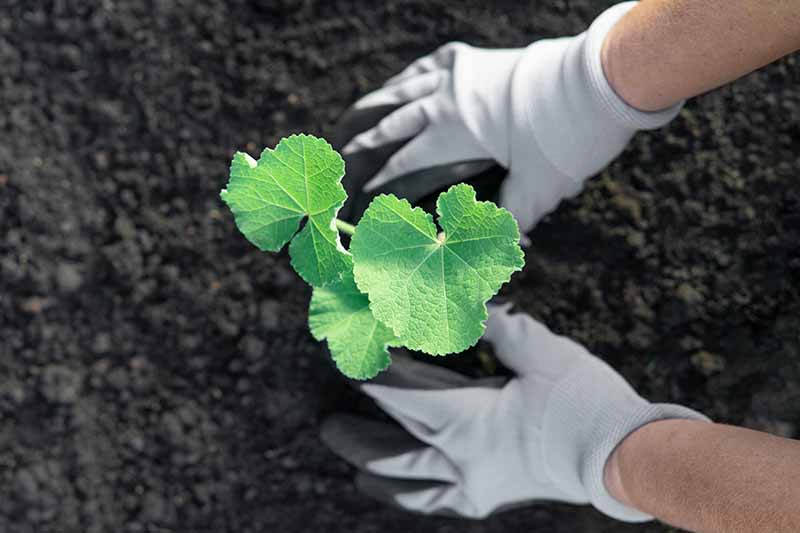

If you grew your seedlings indoors or in a greenhouse, you will have to harden them off by taking them outside for a few hours every day for a week before transplanting, for increasing amounts of time each day.
Established nursery plants can be transplanted in the fall once the weather cools down.
- For seedlings, nursery starts, and potted plants, dig a hole double the size of the root system in width and depth. Gently squeeze around the container to carefully loosen the soil and remove the plant.
- Backfill the soil level around the plant and to the top of the root ball, and provide a deep watering.
New plantings may need protection from direct sunlight, which you can provide with a shade cloth.
Choosing a location along a wall or fence can help to provide support and protection from wind.
How to Grow
Hollyhocks aren’t difficult to grow, but they do have a few quirks that can make the difference between a towering showstopper and a flopped-over mess.
Once they’re established, they’ll bring vertical drama and old-fashioned charm to any garden.
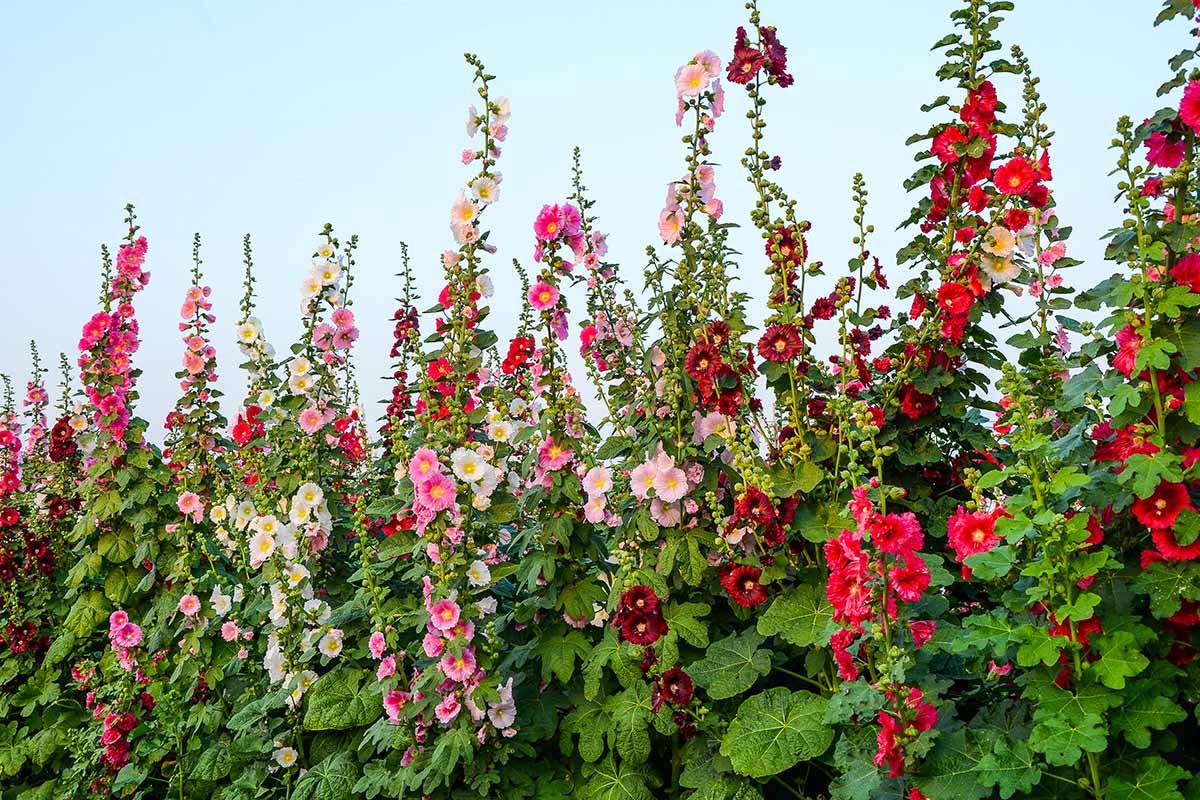

Let’s dive into the essential requirements to keep your hollyhocks healthy and flowering profusely.
Light
Hollyhocks thrive in full sun. They need at least six hours of direct sunlight daily to bloom at their best.
In cooler climates, all-day sun is ideal. In hot southern zones, they’ll appreciate a little afternoon shade to prevent scorched leaves and premature wilting.
Soil
These stately plants prefer rich, well-draining soil, but they’re not terribly picky.
Aim for a loamy medium amended with compost or aged manure before planting. This not only provides nutrients but also improves drainage, which is especially important in heavy clay or compacted soils.
They tolerate a wide range of soil pH (6.0 to 8.0) and are a good option for those trying to grow in alkaline regions.
Temperature and Humidity
Hollyhocks are biennials or short-lived perennials that thrive in USDA Hardiness Zones 3 through 10.
They can tolerate cool weather, even light frost, which helps trigger germination and flowering in second-year plants. But extreme heat and humidity can encourage rust and other fungal issues.
Provide good airflow by spacing plants adequately and avoiding overcrowding to reduce humidity-related problems.
Water
Water at least once a week to encourage root development. As the plants mature, the soil should be kept moist. If it feels dry one inch below the surface, it’s time to water.
Mature hollyhocks are more drought tolerant but will perform best with regular watering. Avoid overhead watering to prevent fungal diseases; water at the base of the plant instead.
Providing a thick layer of mulch around plants helps to maintain moisture. Be sure to spread it a couple of inches away from the stems to allow for proper airflow and discourage disease.
Fertilizer
If you’ve enriched your soil with compost, your hollyhocks may not need additional feeding.
But to encourage bigger blooms, apply a balanced, slow-release fertilizer (such as a granular 10-10-10) in early spring and again midseason.
Alternatively, compost will provide all the nutrients your plants will need.
Avoid over-fertilizing, which can promote foliage growth at the expense of flowers.
Container Growing
It’s possible to grow hollyhocks in containers, but it’s not ideal.
These plants have deep taproots and grow tall—sometimes up to eight feet—so you’ll need a container that’s at least 18 inches deep and very stable to prevent tipping over.
Choose dwarf or compact varieties for better results in pots. Use a rich, well-draining potting mix and keep a close eye on watering needs, as containers dry out faster than garden beds.
Cultivars to Select
The old-fashioned hollyhock look is still desired by many gardeners, even with the option to choose the more dramatic petals that “doubles” offer.
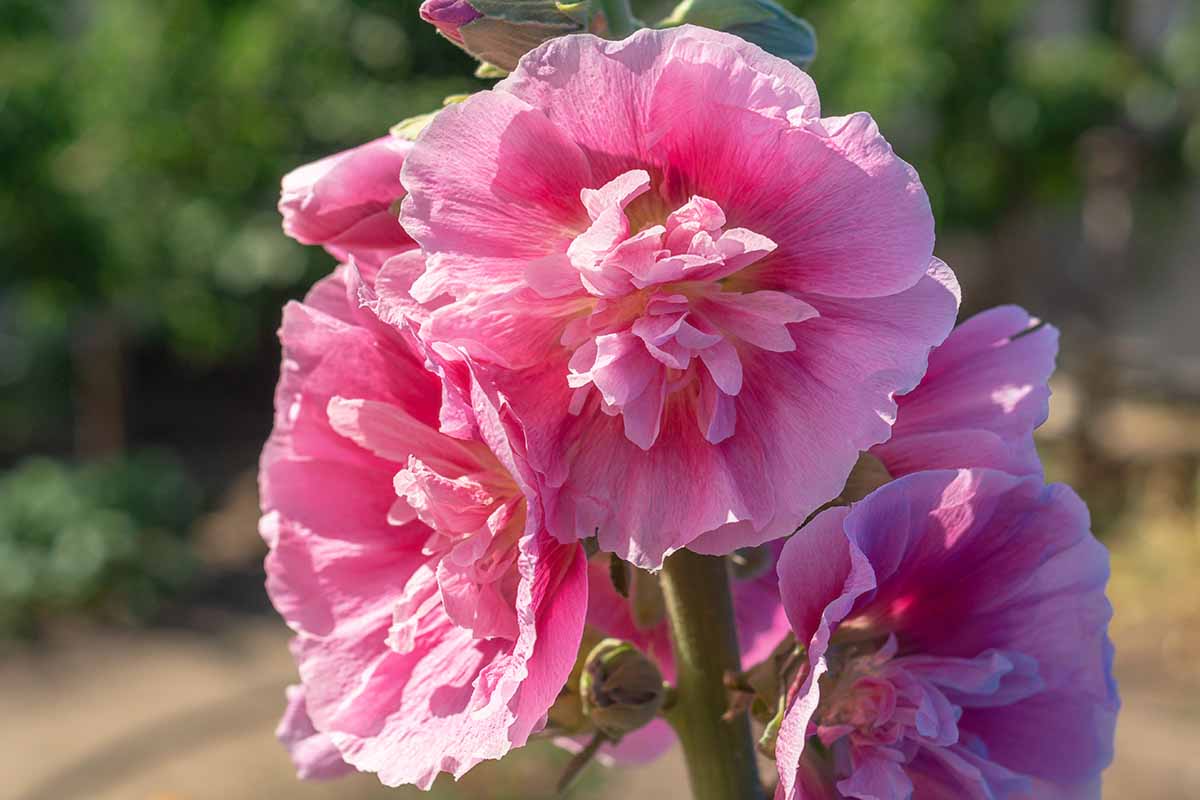

Check with your local plant nursery to see if they carry hollyhock seedlings or established plants, since they are not a common plant that you will see offered by all vendors.
There are many popular varieties of common hollyhocks to choose from.
You can select a specific color or go with a variety that comes in a range of different hues like Country Romance Mix, a selection of true old-fashioned types in shades of rose, white, maroon, yellow, and pink.
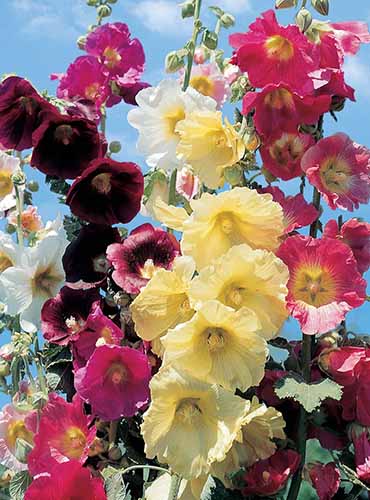

Country Romance Mix
Plants in packs of four are available from Burpee.
For something more dramatic, you could go with ‘The Watchman,’ a popular variety that has black flowers with deep maroon tones, or a two-toned purple-petaled hollyhock like ‘Creme de Cassis.’ Your choice of flower colors is vast!
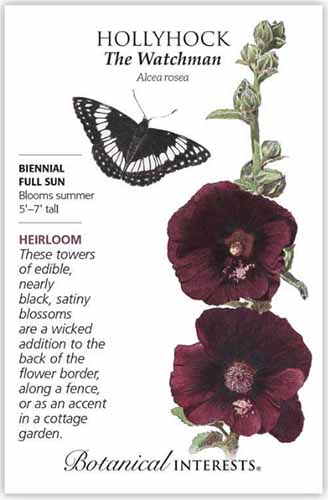

‘The Watchman’
You can find ‘The Watchman’ seeds in 400 milligram packets available from Botanical Interests.
‘Halo Apricot’ is a variety that I’d love to include in my own garden because of the unique color of its flowers, which are peach to pink with cherry eyes.
Also, apricot varieties are often only available as doubles, so it is nice to see a single option in such a dreamy shade.
Maintenance
As the plant grows, flower stalks can benefit from staking for support, especially to help reinforce them during windy weather.
To encourage your plants to continue to grow and bloom for several years, you should deadhead the flowers.
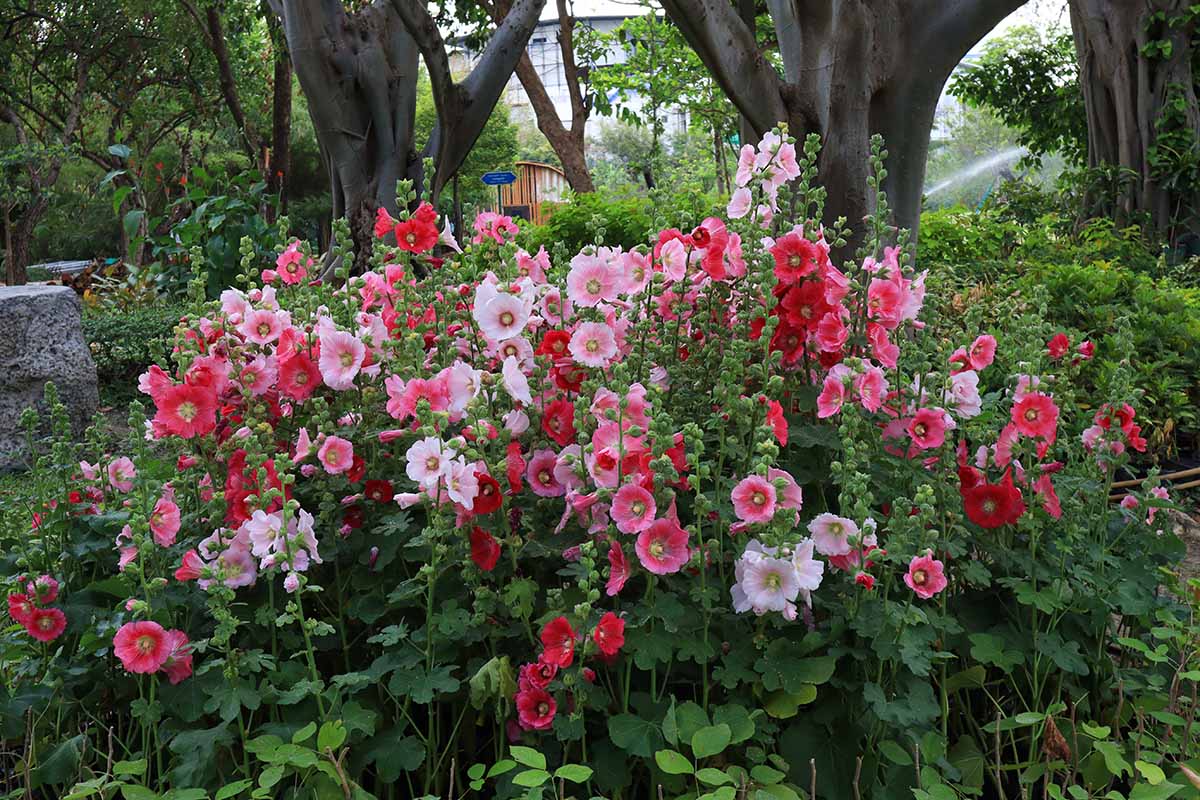

Some gardeners enjoy leaving the flowers in place to go to seed to feed birds, and so they can reseed on their own.
If you find that a hollyhock has self-sown in an undesirable location, you can transplant volunteer seedlings after they have developed their true leaves but before the taproots grow significantly.
Transplanting established hollyhocks in fall is best, if you need to move them to a new location. But note that you will run the risk of damaging the delicate taproot when you dig into the ground to uproot the plant.
After their summer bloom, cut back all remaining flower stalks at the base and plan to transplant them on a day with temperatures above 50°F. Early morning or evening are good times to transplant to prevent heat stress or drying out.
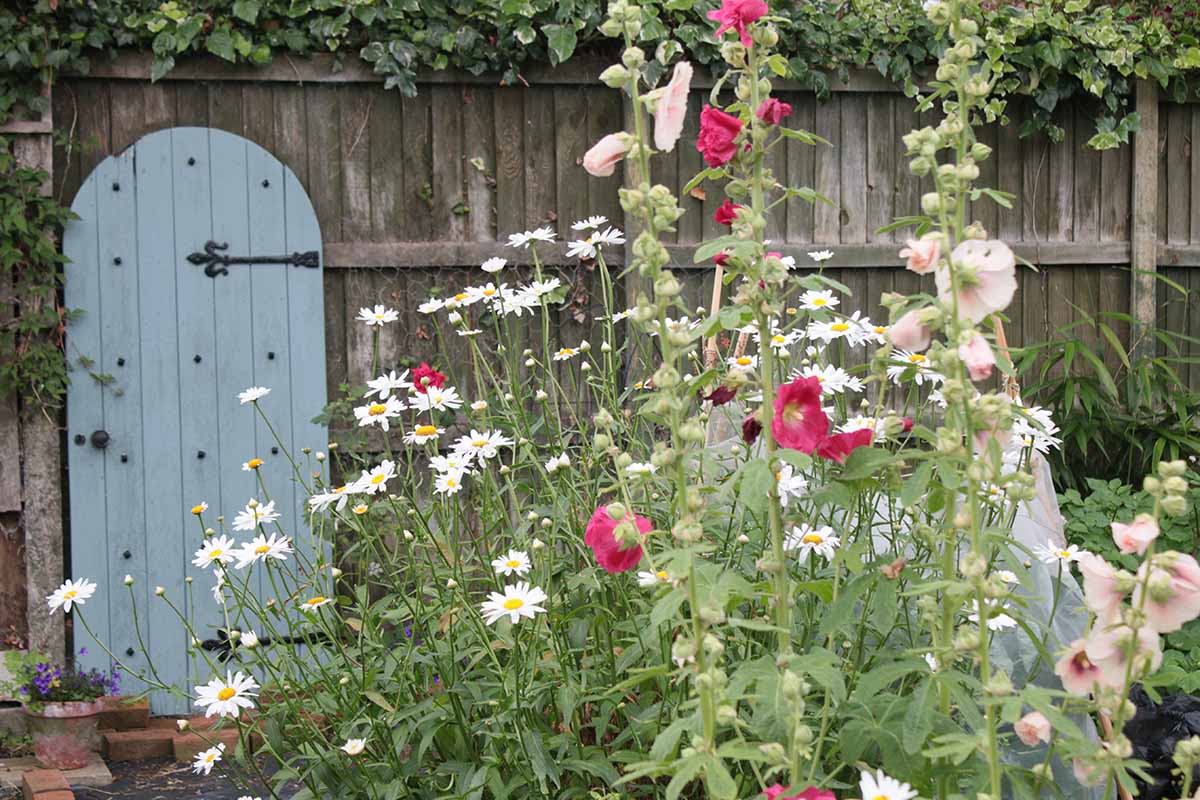

When the season cools down in mid to late fall, cut back foliage and flower stalks to the crown and add a few inches of mulch and compost over them to help them overwinter.
Pests and Disease
Common hollyhocks aren’t particularly vulnerable to pests or disease, but they can have some issues.
Here are a few of the main ones to look out for:
Pests
- Japanese Beetles
These metallic pests chew through foliage, leaving behind skeletonized leaves.
Control: Handpick and drop into soapy water, or spray with neem oil or insecticidal soap. - Aphids
Small, soft-bodied insects that cluster on new growth and buds, sucking sap and leaving sticky honeydew behind.
Control: Spray with water or apply insecticidal soap regularly until the population is under control. - Cutworms
These larvae feed at night, often cutting down young plants at the base.
Control: Place collars around stems and keep the garden free of debris where they might hide.
Disease
- Rust (Puccinia malvacearum)
A common and often serious problem in hollyhocks. Look for orange-brown pustules on the undersides of leaves.
Control: Remove and dispose of infected foliage, avoid overhead watering, and use fungicides if needed. - Powdery Mildew
Appears as a white, powdery coating on leaves, especially in humid conditions.
Control: Improve air circulation, water at the base, and use sulfur-based fungicides to reduce severity.
With consistent monitoring and prompt action, these issues can be minimized, allowing your hollyhocks to thrive throughout the growing season.
Best Uses
Hollyhocks are pollinator-friendly plants that can help to complete your garden space. They make for a fun conversation piece and crafting fun for kids and adults.


They are stunning when placed in bouquets, and the flowers can also be made into cute flower fairy dolls!
I’ve had botanical dyers reach out to ask me if I could share some of my A. rosea var. nigra flowers with them to use.
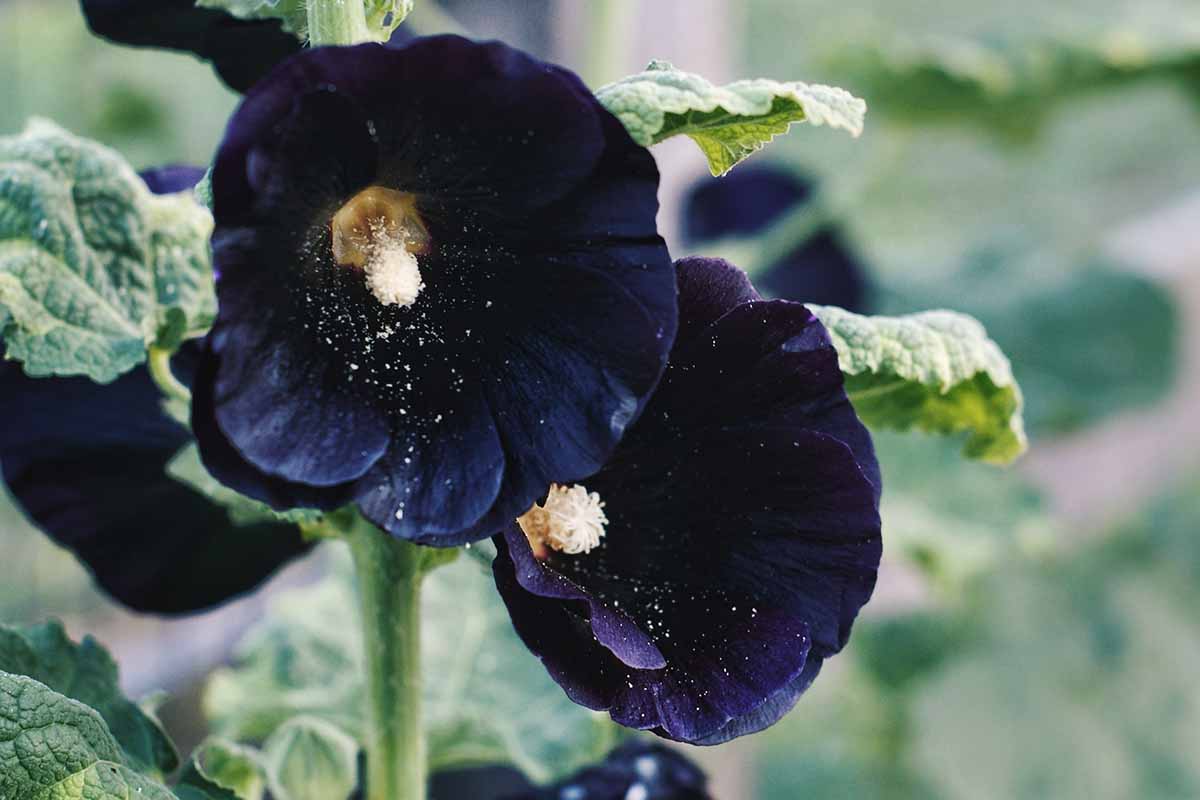

The petals are a dark maroon color that is very close to black, and when simmered in a pot, they release a natural dye that can be used to create beautiful shades of blue, gray, and purple.
Plant Hollyhocks for Picturesque Petals
Hollyhocks are my go-to whenever I need some show-stopping flower magic in the garden.
After reading about these stunning flowers, are you inspired to add some cottage-garden ambiance to your outdoor space?
Growing them in your garden is simple, and it provides an excellent experience for all gardeners. The big, gorgeous blooms create mesmerizing displays while attracting diverse pollinators.


As a gardener who enjoys saving seeds, I appreciate how much seed one plant can produce and enjoy saving and sharing these with friends. In addition, sharing seeds is a great way to connect and discuss gardening with your community.
Thanks for reading! Please share your thoughts and questions in the comments section below!
Looking for even more flowering plants that will help you to transform your space into the pollinator-friendly cottage garden of your dreams? Check out these guides next:



